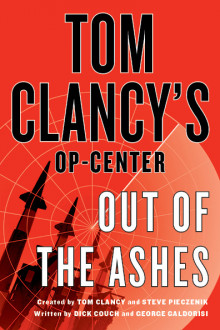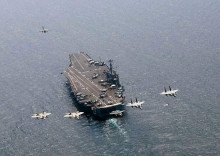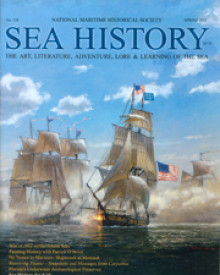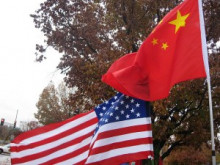
Now just a month away from publication, the first book in the re-booted Tom Clancy Op-Center series, Tom Clancy’s Op-Center: Out of the Ashes has garnered additional praise from early reviews. Here is what Booklist has to say:
Issue: May 1, 2014
Out of the Ashes
Couch, Dick (Author) and Galdorisi, George (Author)
May 2014. 400 p. St. Martin’s/Griffin, paperback, $15.99. (9781250026835). St. Martin’s/Griffin, e-book, (9781250026828).
Tom Clancy’s Op-Center books (12 in all) were popular, but the series ended after the last one was published in 2005. Now, almost 10 years later, St. Martin’s has resurrected Op-Center with this offering from coauthors Couch and Galdorisi. A series of terrorist attacks at NFL stadiums during games causes havoc, and the president’s response does little to restore confidence. He realizes the time has come to reestablish the Op-Center, a group known for its unmatched SWAT, computer, and infiltration skills. The recruitment process takes up the beginning third of the novel and proves surprisingly compelling. Once the team is up and running, the operation to strike back at the terrorists begins. Couch and Galdorisi are veteran military-thriller authors, and they show their talents here. Op-Center fans will be pleased to have the series back and will look forward to more installments in the future.
— Jeff Ayers

In 2014 we find ourselves in awe of technology. And we have been for quite some time. As Arthur Clarke famously said, “Any sufficiently advanced technology is indistinguishable from magic.”
However, as technology had advanced by leaps and bounds, this “magic” has made many people wonder and filled others with fear. Few people can forget the chilling scene from Stanley Kubrick’s 2001: A Space Odyssey: Astronauts David Bowman and Frank Poole consider disconnecting HAL’s (Heuristically programmed ALgorithmic computer) cognitive circuits when he appears to be mistaken in reporting the presence of a fault in the spacecraft’s communications antenna. They attempt to conceal what they are saying, but are unaware that HAL can read their lips. Faced with the prospect of disconnection, HAL decides to kill the astronauts in order to protect and continue its programmed directives.
And it is easy to forget Arthur Clarke’s short story, The Sentinel was published in 1951 and Kubrick’s movie premiered in 1968. We have, indeed, been in awe/fear of technology for a long time. Therefore it should come as no surprise a New York Times Magazine cover story entitled “All is Fair in Love and Twitter is subtitled “The Sweet, Innocent Ideas and Ruthless Power Plays that Created Twitter.” Read more here.

At the heart of Global Trends 2030 are four megatrends that it identifies as the most significant trends that will affect the world looking out over a decade-and-a-half into the future. Previous editions of Global Trends have also identified megatrends, and if there is one part of GT2030 that is the most “mature” and well-developed, it is this mega-trends aspect of the report.
Trends mean just that; extrapolation of things happening today that, if left largely alone, will continue along the path they are on and result in a “tomorrow” that while not “predictable” represents a projection of a future state that is more likely than not. For this edition of Global Trends, four megatrends dominate the landscape. These four megatrends are:
- Individual Empowerment
- Diffusion of Power
- Demographic Patterns
- Food, Water, and Energy
Read more about these megatrends that dominate our world in this Defense Media Network article.

As Steve Jobs famously said, “Innovation distinguishes between a leader and a follower.” Innovation not only distinguishes individuals, it differentiates peoples and nations.
Imagination is not only the uniquely human capacity to envision that which is not, and therefore the fount of all invention and innovation. As the writer J.K. Rowling puts it, “Innovation is arguably most transformative and revelatory capacity, it is the power to that enables us to empathize with humans whose experiences we have never shared.”
When one speaks of innovation, our thoughts immediately go to the icons of Silicon Valley, the Steve Jobs, Bill Gates, and Mark Zuckerberg’s of this world. We look to the tech industry to be our innovative engine.
But new theories are challenging this assumption. Increasingly, however, economists and social thinkers are challenging the conventional wisdom on innovation. Speaking at the Institute for New Economic Thinking conference in Toronto, Mariana Mazzucato, a professor at the University of Sussex, described the most notable technology innovations as coming from the government, not the private sector. Read more about this controversial new theory in this New York Times article here.

In a previous post we talked about the United States rebalance to the Asia-Pacific region. This shift encompasses many aspects: political, diplomatic, economic and military. From the military perspective, the AirSea Battle Concept operationalizes this shift.
The Air-Sea Battle Concept, modeled after the Army-Air Force Air Land Battle Doctrine of a previous generation, has been heralded by some as the answer to compelling strategic and operational challenges facing the U.S. military today.
From its inception, the U.S. military has continuously adapted itself to meet evolving threats. At its core, the Air-Sea Battle Concept is about reducing risk and maintaining U.S. freedom of action and reflects the services’ most recent efforts to improve U.S. capabilities. Similar to previous efforts, the concept seeks to better integrate the services in new and creative ways. It is a natural and deliberate evolution of U.S. power projection and a key support component of U.S. national security strategy for the 21st century.
Read more here on the Defense Media Network website.

Most everyone at least considers writing at some point in their lives. For those of us not as gifted as the Hemingways, Fitzgeralds and Faulkners of this world, sometimes some writing techniques can come in handy. Here is a suggestion from Silas House, author of five novels as well as plays and works of nonfiction:
“To Kill a Mockingbird would certainly have had little effect without the presence of memorable folks like Scout, Jem, Dill, Atticus and Calpurnia. The Outsiders wouldn’t have meant much to me without Ponyboy, Johnny, Cherry Valance and all the others. The Color Purple only took up housekeeping in my heart because of characters like Celie, Shug and Sofia.
Characters are what make us love fiction, what make the stories stick with us and speak to us. Yes, plot and sense of place and action and the language are hugely important. But a novel would be a boring affair indeed without those who populate it.
The point is that I didn’t come to care about Scout or Ponyboy or Celie because of how they looked. I cared about them because I knew what was going on in their minds and hearts. Readers are better informed if we give them what is in a character’s brain, not what is on her body. ”
Read more about writing techniques in Silas House’s article in the New York Times.

The Kissing Sailor continues to generate interest – and controversy – as readers everywhere deep dive into the compelling proof that George Mendosa and Greta Zimmer Friedman – two national treasures and icons that are both “fit and feisty” at 91 are indeed, without a doubt, the two principals in America’s favorite picture. Read more of the current state of the art in this review in Sea History Magazine

Tom Clancy, the most well-known military writer in a generation was universally hailed as being prescient about regarding the future of intelligence, technology and military operations in his books seemed to come to pass five, ten, or more years later.
Not all of us are so prescient about what our future world will look like. But there is a source – and an open source – available to all of us that looks deep into the future in the areas of international affairs, i.e. what our world will look like in the ensuing decades, technology and military operations.
While many organizations – inside and outside of government – of necessity look to the future to attempt to discern what the future security environment portends, the National Intelligence Council represents the “Pros from Dover,” in this regard. The NIC supports the director of national intelligence in his role as head of the intelligence community (IC) and is the IC’s focal point and governing organization for long-term strategic analysis.
Among the projections in its groundbreaking report, Global Trends 2030: Alternative Worlds:
- China’s economy is set to overtake that of the United States in the 2020s, but China will not challenge the United States’ preeminence or the international order;
- Asia will become more powerful than both North America and Europe combined (based on population, GDP, military spending, and technological investment);
- The United States will achieve energy independence with shale gas, and;
- Wider access to disruptive technologies – including precision-strike capabilities, cyber instruments, and bio-terror weaponry – could increase the risk of large-scale violence and disruption.
Read more about Global Trends 2030 and looking to the future on the Defense Media Network Website here.

Call it enrichment, self-actualization, reaching your full potential or anything else. As we blast through our busy lives in search of that “something” we often don’t pause to look inward and take a moment to ask ourselves why we are doing what we are doing.
The current Mindfulness Meditation movement, championed by visionaries such as Google’s Chade-Meng Tan whose book, Search Inside Yourself has garnered stellar reviews, is catching fire where people’s lives are on fast-forward on steroids – Silicon Valley.
His book is fabulous – and highly recommended – but you can dip your toe in the water to experience what Mindfulness Meditation is all about with this excellent New York Times article.

North Korea armed with nuclear missiles. Iran developing nuclear weapons they can put on a variety of missiles. Troubles with Russia over the Ukraine and fears Russia might flex its muscles with missiles armed with nuclear warheads. The question many are – and should be – asking is this: What capability does the United States have to deal with this kind of existential threat.
While all the U.S. military services have a stake in ballistic missile defense the U.S. Navy is now in the lead in this important warfare area. This journey is a remarkable success story – and one not yet told. Over a period of sixty years, the U.S. Navy has evolved the most versatile, and most successful, naval air and missile defense system in the world. However, it is a journey that has been fraught with difficulty, advancing not in linear fashion, but in fits and starts, always pushing the edge of the technological envelope until it arrived where it is today.











